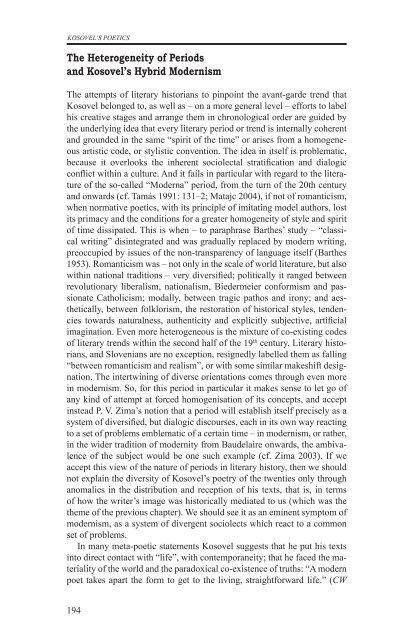razprave (pdf) - Društvo za primerjalno književnost - ZRC SAZU
razprave (pdf) - Društvo za primerjalno književnost - ZRC SAZU
razprave (pdf) - Društvo za primerjalno književnost - ZRC SAZU
- No tags were found...
You also want an ePaper? Increase the reach of your titles
YUMPU automatically turns print PDFs into web optimized ePapers that Google loves.
KOSOVEL’s poeticsThe Heterogeneity of Periodsand Kosovel’s Hybrid ModernismThe attempts of literary historians to pinpoint the avant-garde trend thatKosovel belonged to, as well as – on a more general level – efforts to labelhis creative stages and arrange them in chronological order are guided bythe underlying idea that every literary period or trend is internally coherentand grounded in the same “spirit of the time” or arises from a homogeneousartistic code, or stylistic convention. The idea in itself is problematic,because it overlooks the inherent sociolectal stratification and dialogicconflict within a culture. And it fails in particular with regard to the literatureof the so-called “Moderna” period, from the turn of the 20th centuryand onwards (cf. Tamás 1991: 131–2; Matajc 2004), if not of romanticism,when normative poetics, with its principle of imitating model authors, lostits primacy and the conditions for a greater homogeneity of style and spiritof time dissipated. This is when – to paraphrase Barthes’ study – “classicalwriting” disintegrated and was gradually replaced by modern writing,preoccupied by issues of the non-transparency of language itself (Barthes1953). Romanticism was – not only in the scale of world literature, but alsowithin national traditions – very diversified; politically it ranged betweenrevolutionary liberalism, nationalism, Biedermeier conformism and passionateCatholicism; modally, between tragic pathos and irony; and aesthetically,between folklorism, the restoration of historical styles, tendenciestowards naturalness, authenticity and explicitly subjective, artificialimagination. Even more heterogeneous is the mixture of co-existing codesof literary trends within the second half of the 19 th century. Literary historians,and Slovenians are no exception, resignedly labelled them as falling“between romanticism and realism”, or with some similar makeshift designation.The intertwining of diverse orientations comes through even morein modernism. So, for this period in particular it makes sense to let go ofany kind of attempt at forced homogenisation of its concepts, and acceptinstead P. V. Zima’s notion that a period will establish itself precisely as asystem of diversified, but dialogic discourses, each in its own way reactingto a set of problems emblematic of a certain time – in modernism, or rather,in the wider tradition of modernity from Baudelaire onwards, the ambivalenceof the subject would be one such example (cf. Zima 2003). If weaccept this view of the nature of periods in literary history, then we shouldnot explain the diversity of Kosovel’s poetry of the twenties only throughanomalies in the distribution and reception of his texts, that is, in termsof how the writer’s image was historically mediated to us (which was thetheme of the previous chapter). We should see it as an eminent symptom ofmodernism, as a system of divergent sociolects which react to a commonset of problems.In many meta-poetic statements Kosovel suggests that he put his textsinto direct contact with “life”, with contemporaneity; that he faced the materialityof the world and the paradoxical co-existence of truths: “A modernpoet takes apart the form to get to the living, straightforward life.” (CW194
















